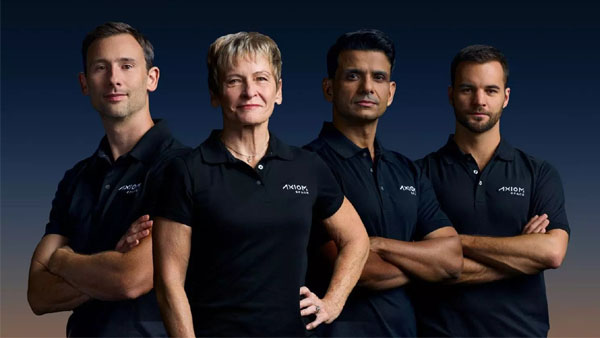By Dipak Kurmi
The early hours of June 26, 2025, marked a defining moment in India’s space history as Group Captain Shubhanshu Shukla lifted off aboard the Axiom Mission 4 (Ax-4) to the International Space Station (ISS). Ten minutes into the mission, Shukla, in a voice filled with both emotion and determination, delivered a brief but significant message: this mission was not just about reaching space, but about heralding the beginning of India’s human spaceflight era. His words may not yet echo with the poetic resonance of Rakesh Sharma’s iconic “Saare Jahan Se Achha,” spoken from space 41 years ago, but their strategic and symbolic significance is undeniable.
Shukla’s journey is the latest chapter in India’s long and carefully built ambition to become a leading spacefaring nation. His presence on the Ax-4 mission not only places India on a larger international spaceflight map but also solidifies its position as a serious contender in the evolving geopolitics of space exploration.
At 39, Shubhanshu Shukla is already a decorated officer of the Indian Air Force, with over 2,000 flying hours across a range of aircraft including the Su-30 MKI, MiG-21, MiG-29, Jaguar, and Dornier transport planes. His journey from the skies to space was neither accidental nor sudden. Commissioned into the fighter stream of the IAF in 2006, Shukla’s distinguished career as a combat leader and test pilot positioned him as one of the most suitable candidates for India’s ambitious Gaganyaan program. In 2019, ISRO tapped him and three other IAF pilots for India’s first human spaceflight mission. Their training, conducted at Russia’s prestigious Yuri Gagarin Cosmonaut Training Center in Star City, Moscow, was an intensive year-long process designed to prepare them for the rigors of space.
Shukla’s selection for the Axiom-4 mission is a strategically calculated move by ISRO and the Government of India. Though this mission is conducted in partnership with Axiom Space, a private American space company, ISRO has been an equal technical and logistical partner from the very beginning. A significant ISRO team, including Chairman V Narayanan, was stationed in the United States during the final preparation phase of the mission. Their involvement went beyond ceremonial participation; they were integral to troubleshooting the last-minute technical delays that repeatedly pushed back the launch date.
Shukla’s successful journey to the ISS is expected to provide ISRO with crucial experiential data for the upcoming Gaganyaan mission, now scheduled for 2027. The Ax-4 mission will help ISRO fine-tune several human spaceflight parameters such as life support systems, emergency procedures, space medicine, and crew safety mechanisms. Shukla’s flight offers ISRO a live case study of how an Indian astronaut operates and adapts in microgravity aboard the ISS—an environment the Gaganyaan astronauts will not directly experience, as India’s first human space mission will be an independent Low Earth Orbit (LEO) flight, not a docking mission.
This milestone marks a transition for ISRO from a satellite-launching powerhouse to a fully integrated human spaceflight agency. Though India missed its original goal of launching Gaganyaan by 2022—a deadline inspired by the 75th anniversary of Indian independence—the delay has arguably worked in ISRO’s favor, giving the space agency time to build and test human-rated launch vehicles and life support systems with enhanced safety protocols.
More broadly, human spaceflight is no longer a vanity project but a strategic necessity for nations with geopolitical ambitions in the new space economy. The United States and China are aggressively working toward building permanent bases on the Moon and setting long-term objectives for Mars missions. For India, ensuring an indigenous capability for human space travel is central to securing its interests in this high-stakes frontier. The Axiom-4 mission is an essential step in preventing India from being left behind in what many call the “New Space Race.”
India’s space diplomacy has also entered a new orbit with this mission. Unlike Rakesh Sharma’s 1984 spaceflight aboard a Soviet Soyuz spacecraft, which was a bilateral Indo-Soviet partnership, Shukla’s Ax-4 mission places India as an active collaborator in a multi-stakeholder, commercially driven international space environment. ISRO’s partnership with Axiom Space reflects the changing dynamics of space exploration, where private players and public agencies from different countries increasingly work together on human missions.
The Ax-4 mission is also critical for India’s space industry ambitions. Currently, India commands less than 2 percent of the global space economy, despite being recognized as one of the top five spacefaring nations in terms of launch capability and mission diversity. India’s emergence in human spaceflight will act as a magnet for domestic talent, international partnerships, and private sector investment. Much like how the Chandrayaan and Mangalyaan missions inspired a generation of Indian engineers and scientists, Shukla’s journey to the ISS will likely invigorate interest in space science and aerospace technology among Indian youth.
Further, the mission fits into India’s larger plans for space. ISRO has already announced that it aims to establish its own space station by 2035 and land an Indian astronaut on the Moon by 2040. These targets, ambitious though they are, now seem more achievable given the experience and international exposure being gained through missions like Ax-4.
Shukla’s flight also brings a renewed focus on the critical link between India’s defense establishment and its space program. As a Group Captain in the Indian Air Force, Shukla symbolizes the growing interface between military aviation and space technology in India. His background as a combat leader and test pilot aligns well with the high-stakes, high-risk environment of human spaceflight. This strategic overlap also suggests that India’s space capabilities could evolve dual-use dimensions—both civilian and military—as the security landscape extends into outer space.
However, while the Ax-4 mission is a cause for national celebration, it also underscores the need for India to accelerate investments in space infrastructure, astronaut training, and human-rated launch systems. The experience ISRO gains from this mission will be invaluable, but it must quickly translate that into indigenous capabilities for upcoming missions.
As Shubhanshu Shukla orbits the Earth aboard the ISS, he carries with him not just the Indian tricolour, but also the hopes of a billion people eager to see their country take its rightful place among the elite few nations with a sustainable human spaceflight program. His words, spoken just minutes after liftoff, echo the determination of a new generation of Indian spacefarers ready to write their own chapter in the annals of space exploration.
The journey from Lucknow to Low Earth Orbit is not just a personal triumph for Group Captain Shukla, but also a monumental leap for India’s space program. As he looks down upon the Earth from space, perhaps he, like Rakesh Sharma before him, will find words that encapsulate both the pride and promise of a rising spacefaring India.
(the writer can be reached at dipakkurmiglpltd@gmail.com)




